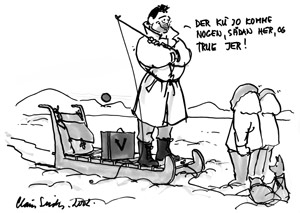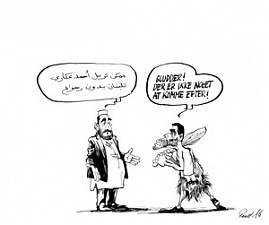Culture, Democracy , EU – Baltic States, Forum
International Internet Magazine. Baltic States news & analytics
Saturday, 13.09.2025, 05:15
Culture + politics = satirical drawings: math in democracy
 Print version
Print version |
|---|
The democratic value of satire in general and of cartoons in particular cannot be overestimated. Subtle language of humor embodied in cartoons has a definite impact on various sides of politicians and citizens at large way of life. It is hard to imagine democracy without satirical drawings: through satire the population has acquired a powerful – and smiling- weapon against politicians’ mistakes and drawbacks.
People’s right to free expression has turned the drawings’ humor into opposition’s assets. Even the main public figures in a democracy, such as a Prime Minister, are not immune to criticism. They have to be on their toes to avoid being the target of cartoonists’ shafts of satire.
It is widely acknowledged in a Western democracy that the level of “satirical freedom” can serve as an important determinant of a country’s openness and freedom. It is in this regard that the Danish drawings represent a fair reflection of the country’s mentality, culture and political attitude towards democracy. It is especially true for political caricatures that made the Danish prime ministers an object of political culture art through the last 150 years.
Prime Ministers’ under fire
Claus Seidel’s guided tour around the exhibition (Mr. C. Seidel is the chairman of the Danish Cartoonists Union) assisted the BC’s correspondent in understanding why the prime ministers have been the target of “satirical weapons”. The title of a prime minister was introduced into the country’s constitution of 1915 and the post officially functioned from April 1918. Since then with the interval of 4-5 years (sometimes just several days or moths) there were more than 30 prime ministers in Denmark, a good selection of “victims” for the cartoonists.
As the head of government, the Prime Minister presides over the council of ministers and submits a report on the general position of the realm with intended government measures. The council of ministers’ decisions are made by the majority vote and the prime minister sums up and formulates the government attitude in each political case. It is precisely here that the sharp cartoonist’s pencil catches the “funny thing”.
The exhibition presents more than 200 drawings, selected from a collection of about 150 thousand original drawings, several of which are considered as classics in the Danish political satire and are even reprinted in schoolbooks on national history.
Freedom of artistic expression
 |
|---|
For decades the cartoonists have contributed to the political debate in Denmark with their witty and often quite sharp cartoons. These drawings in dailies have been used by the artists as a free hand in expressing thoughts and criticism on various political agenda issues.
The talented cartoons helped both to set the political life in motion and influence people’s perception of politicians’ personality and identity. Thus, for example, politicians’ way of “conducting” a fair dialogue is best explained in the Roald Als’ drawing “Dialog”, reflecting present Danish Prime Minister Anders Fogh Rasmussen as a caveman with a cudgel to hit and destroy his opponents.
Or another example in Claus Seidel`s drawing: the United States will place its missile shield in Greenland and Denmark's prime minister takes up to convince the Greenlanders on lack of any seriousness...
The first political cartoons appeared in Denmark in 1852 and were connected to the border conflict with Germany; though since 1864 political satire focused almost exclusively on domestic policies embodied by the head of government.
Sensitive balance
Considerable efforts in the artist’s talent are needed to make a political cartoon as well as the perception to produce what is called the “drawing of the day”. The cartoonist both comments on and draws a picture on any kind of political event in the country. However it needs an artist’s ability to find a sensitive balance between credibility and respect for the “situation” under the review.
The “sense of balance” in the cartoon includes, according to C. Seidel’s opinion, a cocktail of seriousness, sharpness of satire and elegant humor. It is in this way that a cartoonist effectively participates in the country’s democratic process. But to do so he or she needs the courage and conviction. Therefore the drawing must not only catch readers’ attention but also have an impact on the understanding of the country’s policy and be a satire on the politicians’ character.
If this balance is there, something unique happens, i.e. the cartoonist’s vision becomes that of the readers, argued C. Seidel.
The Danish Prime Minister, A.F.Rasmussen (being on the post since November 2001) attended the opening of the exhibition and spoke of the importance of the drawings for political and democratic development in a modern society.
The exhibition is at the Danish Royal Library’s new building (“Black Diamond”) until the end of October.
Pictures from the exhibition are presented here by courtesy of the artists.








 «The Baltic Course» Is Sold and Stays in Business!
«The Baltic Course» Is Sold and Stays in Business!

